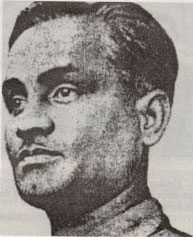Hockey Wakes Up
When cricket teams visit Kolkata, the city draws enormous crowds, and they say the same for the South Club tennis tournaments.
Autobiography of Hockey Wizard Dhyan Chand
Published by Sport & Pastime, Chennai, 1952
| Page 1 | Page 2 | Page 3 |
|
Page 4 | Page 5 | Page 6 |
Hockey Wakes Up | Kolkata has always perplexed me. During the football
season you will see thousands of people watching the football matches. In
the Beighton Cup hockey tournament, and during the Inter-Provincial hockey
tournament, I have seen the largest possible crowd at the hockey matches in
Kolkata.
When cricket teams visit Kolkata, the city draws enormous crowds, and they say the same for the South Club tennis tournaments. |
|||||
| Page 7 | Page 8 | Page 9 | Page 10 | Page 11 | Page 12 | |
![]() e
heard whispers that India might send a team to the hockey event in the 1928
Amsterdam Olympic Games. You may perhaps remember that there was no hockey event
after the 1920 Antwerp Games. Hockey was scrapped at the 1924 Paris Olympic
Games, and many felt that hockey perhaps would not be reintroduced.
e
heard whispers that India might send a team to the hockey event in the 1928
Amsterdam Olympic Games. You may perhaps remember that there was no hockey event
after the 1920 Antwerp Games. Hockey was scrapped at the 1924 Paris Olympic
Games, and many felt that hockey perhaps would not be reintroduced.
The Indian Hockey Federation (IHF) had come into existence by then in a very small way. It was born in Gwalior sometime in 1926 during the Scindia Gold Cup hockey tournament, and became active in 1928. We heard that the IHF was trying its best to persuade the International Olympic Committee (IOC) to include hockey as an Olympic event.
The news at first did not give me any kick. I just passed it over and never bothered about it, though my friends in my regiment constantly harped upon it. Gradually I also started thinking - would India really send a team to the Amsterdam Olympics, if so, would the civilian hockey authorities include an Army man like me in the side, and if I did go, would my people at home like it, and would I be able to live up to the expectations of those who selected me?
My people in the regiment felt that if India did send a team to the Olympics, the Army would not be neglected. Their case was that the IHF in those days was largely conducted by Army men; in fact the president of the IHF was Major Burn-Murdoch.
India's request was accepted by the IOC and the IHF decided to send a team to the Amsterdam Olympics. The IHF was confronted by two major problems - how to raise the best possible team from the very few Provincial Associations in existence those days, and secondly, what procedure to use to pick the best possible players. The IHF decided to hold the trials at Kolkata, as Kolkata had always been the only centre to draw enormous crowds for all kinds of games.
Kolkata has always perplexed me. I have seen cities that take special interest in one particular game. Take Mumbai for instance. When she stages first class cricket matches, for example, the Pentangular Cricket Festival, you will find enormous crowds watching the tournament. Even if the Rovers Cup tournament drew the best possible football teams from all over India, you would not find such a large crowd at the Cooperage as compared to the crowd at the Pentangular tournament. And in my time when I played hockey in Mumbai, even the Aga Khan hockey tournament did not draw very many people.
So far as Kolkata is concerned, it is a strange city in a way. It is immaterial who is playing. During the football season you will see thousands of people watching the football matches. In my time in the Beighton Cup hockey tournament, and during the Inter-Provincial hockey tournament, I have seen the largest possible crowd at the hockey matches in Kolkata.
I have heard that when foreign cricket teams visit Kolkata, the city draws enormous crowds, and they say the same about their crowds for the South Club tennis tournaments. The IHF naturally thought that Kolkata was the best centre to hold the trials. It provides the best grounds and the most crowds in the country, and the IHF was badly in need of money.
You may perhaps know that the Bengal Hockey Association was the oldest hockey association in India, having been formed sometime in 1908. Between 1926 and 1928, two or three other provincial associations came into existence.
The Punjab Hockey Association was founded, as far as I can remember, sometime in 1926, largely due to the efforts of men like Messrs. C. E. Newham and G. D. Sondhi. After its formation, the association sent a provincial side to Kolkata in 1926 to play Bengal in the first official Inter-Provincial hockey contest staged in this country.
There is a feeling in some ill-informed quarters that Englishmen did not do much for hockey in India. This is not quite true. For my hockey I am gratefully indebted to British Army Officers who not only took great interest in this game, but also played with us on all occasions forgetting their official rank and status.
I heard from my good old friend Jaffar that Mr. Ritchie was responsible for raising the standard of hockey in Punjab. Jaffar told me that he learnt most of his hockey from Ritchie, who was a professor at the Chiefs' College in Lahore. This Mr. Ritchie captained the Punjab team in 1926 against Bengal, which was captained by the great all-rounder Alec Hosie, who played hockey for Oxford University, Association Football for the Corinthians in London, and cricket for Hampshire and England.
![]()

Dhyan Chand - A Striking Personality
![]()